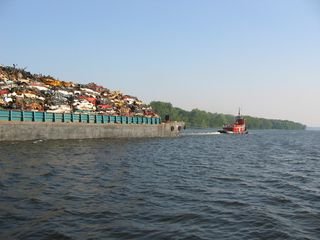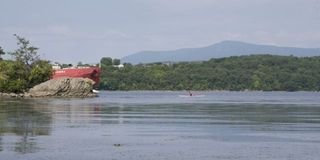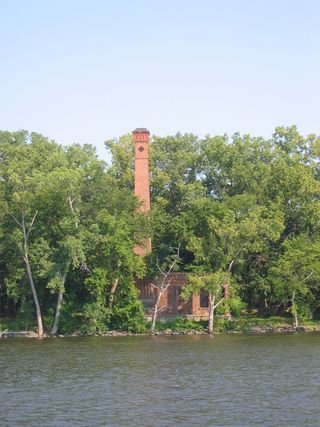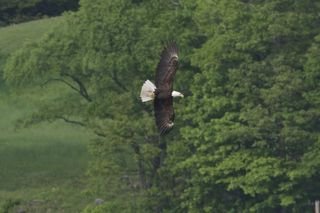Paddling to Nowhere

I write “the water” because at the point I was slipping my boat into the calm river I did not know the name of the Oneida river. I noted the launch site on my map, and as I drove home from a lovely visit to a writing class in Oswego, decided to make a short paddle stop. I didn’t know where this river ran or what I would see. In this way I concoct small adventures.
I struck out to the east. The river divided and I chose the left fork. Houses lined the water, docks allowing easy access for small motorboats. The river was about one-hundred and fifty yards wide. I paddled down the middle, flushing mallards and a stray great blue heron that loitered on the far shore from the houses. The river felt intimate and calm and I wondered at these hundred or so people who got to live there, watching the river shift along: what did they see? No one was home, though I wished for someone to appear so I could ask where this river led, what this river is called.

I write “the water” because at the point I was slipping my boat into the calm river I did not know the name of the Oneida river. I noted the launch site on my map, and as I drove home from a lovely visit to a writing class in Oswego, decided to make a short paddle stop. I didn’t know where this river ran or what I would see. In this way I concoct small adventures.
I struck out to the east. The river divided and I chose the left fork. Houses lined the water, docks allowing easy access for small motorboats. The river was about one-hundred and fifty yards wide. I paddled down the middle, flushing mallards and a stray great blue heron that loitered on the far shore from the houses. The river felt intimate and calm and I wondered at these hundred or so people who got to live there, watching the river shift along: what did they see? No one was home, though I wished for someone to appear so I could ask where this river led, what this river is called.

Soon, the riverside houses started to bore me. I wanted the intimacy of cattails and maybe a turtle or two soaking in the last of the summer’s warmth. I wanted sparrows dashing from sight. And if I could not have that peacefulness of no-people, I wanted a cement plant to entertain me.
Just as I was deciding to turn back, to give up trying to find the magic of this little river, it took a sharp bend. In front of me yawned an underpass. A man stood with a fishing pole on the far side of the pass, as I coasted into a narrow channel, grass and cattails in front of me. My heart soared. “Excuse me,” I said, “what is the name of this river?” The man looked surprised to hear a voice. “I don’t know it’s name. But around these parts we call it Big Bend.” “Thanks. What are you catching?” “A few sunnies.”

Post-Irene Paddle
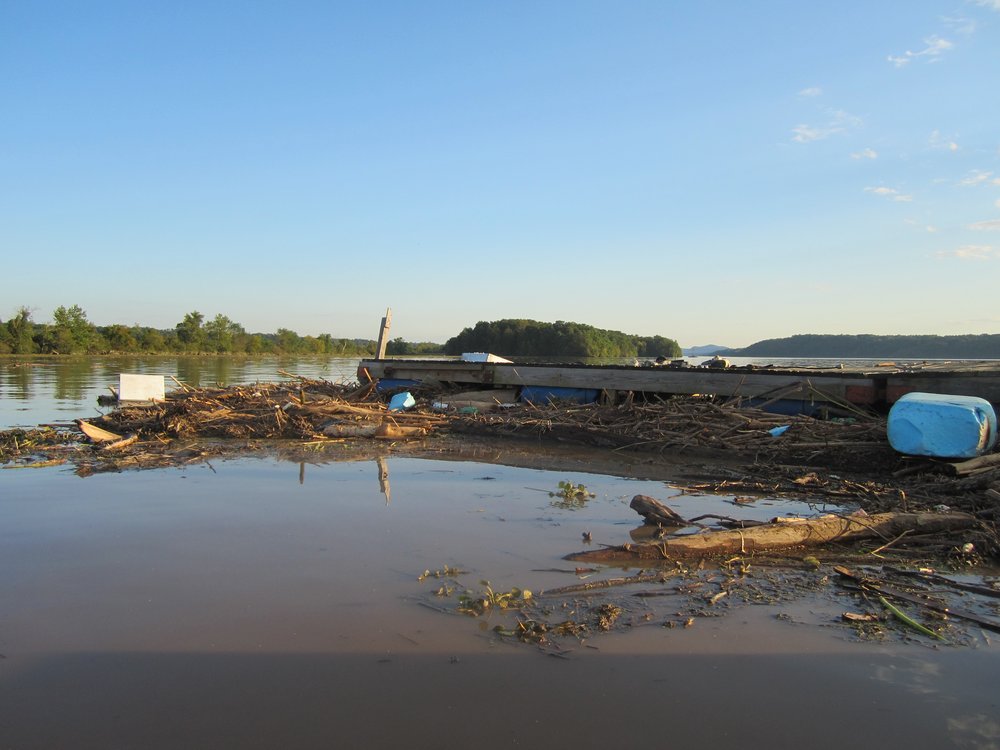
I stepped into my boat, noting the cold at my ankles was not the fall-warmed water of a few days earlier. I struck south, passing a wooden dock, sloshed up on shore. Swallows zipped across the water and landed on the wires next to the train tracks. A great blue heron took flight. In many ways, it was just another day for the birds, and for the baby map turtle I saw taking in the last of the day’s sun. But for me, the river was transformed. I recognized everything: the Catskill mountains in the distance, the puff of trees in front of me that is Magdalen Island, the houses on shore that peer down at the river. But the texture of the river was foreign. There was a sense of dereliction, I want to say of lawlessness. It was as if the river itself was not following its own laws, but also that those who live in and on the river had given over to new ways of being, one where anything could and did float off in the river.

I stepped into my boat, noting the cold at my ankles was not the fall-warmed water of a few days earlier. I struck south, passing a wooden dock, sloshed up on shore. Swallows zipped across the water and landed on the wires next to the train tracks. A great blue heron took flight. In many ways, it was just another day for the birds, and for the baby map turtle I saw taking in the last of the day’s sun. But for me, the river was transformed. I recognized everything: the Catskill mountains in the distance, the puff of trees in front of me that is Magdalen Island, the houses on shore that peer down at the river. But the texture of the river was foreign. There was a sense of dereliction, I want to say of lawlessness. It was as if the river itself was not following its own laws, but also that those who live in and on the river had given over to new ways of being, one where anything could and did float off in the river.
The raft of logs and sticks laced with debris was so thick at the entrance to the north Tivoli Bay that I could hardly shove my way through. The water poured out of the narrow entrance to the Bay, pushing me quickly south. There, just a hundred yards off of Magdalen Island was a small island of river junk. A long wooden dock. A large refrigerator and a small refrigerator both knocked against the wood. A pile of sneakers stacked on top of one end of the dock. On the far end, a submerged motorboat, engine still attached was lashed to dock. It too had been dragged south.

So I headed south, seeing a brilliant orange red scarlet tanager in the late day sun, several king birds, and a kingfisher. I thought I might scoot into the North Bay from the southern entrance. But the water there, which I know to be sweet, often placid, was so fast, so violent I knew I couldn’t make my way against the current. So I headed north, taking to the river side of Magdalen Island.

Indian Point
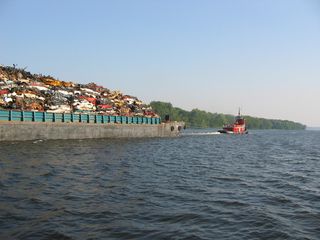
From water level, the towers loomed above me and the entire structure felt imposing. There are layers of red brick buildings smack against the river. Not a window in sight, as if whatever was contained inside shouldn’t be seen, and should not see out. I’d passed some large industry on the river—Trapp Rock up by Poughkeepsie, for instance, but nothing that felt ominous like the Indian Point plant. There are many reasons to protest nuclear power. In my life, the stories of Three Mile Island, Chernobyl and Fukushima are enough to convince anyone this is a risky source of energy. There are many reasons not to want a nuclear power plant so close to a major metropolitan area—9/11 is enough to show how vulnerable we can be. And there are many reasons not to want a nuclear power plant on the Hudson River. The plant rests on a small earthquake fault. And, the plant uses billions of gallons of water t o cool its towers and then spits this warmed water back into the river, altering the ecosystem. In the process, millions of fish are sucked into the plant and killed. But I had not thought about any of this with much care until I stroked past the plant low in my boat.

One spring, I loaded up my kayak with sleeping bag and food and pointed south on the Hudson River. I was traveling with a former student, Emmet, and we intended to take a few days, camping on islands and on the banks of the river, to make our way from my village of Tivoli to Manhattan (I write about this adventure in my upcoming book, MY REACH). This is the freedom of a river, to head out and see what you can see. And I did see many marvelous things on my journey, and lots that I wish I had not seen. Day four I passed the Indian Point nuclear power plant. Instinctively, we scooted to the western shore, giving the plant a wide berth.
From water level, the towers loomed above me and the entire structure felt imposing. There are layers of red brick buildings smack against the river. Not a window in sight, as if whatever was contained inside shouldn’t be seen, and should not see out. I’d passed some large industry on the river—Trapp Rock up by Poughkeepsie, for instance, but nothing that felt ominous like the Indian Point plant. There are many reasons to protest nuclear power. In my life, the stories of Three Mile Island, Chernobyl and Fukushima are enough to convince anyone this is a risky source of energy. There are many reasons not to want a nuclear power plant so close to a major metropolitan area—9/11 is enough to show how vulnerable we can be. And there are many reasons not to want a nuclear power plant on the Hudson River. The plant rests on a small earthquake fault. And, the plant uses billions of gallons of water t o cool its towers and then spits this warmed water back into the river, altering the ecosystem. In the process, millions of fish are sucked into the plant and killed. But I had not thought about any of this with much care until I stroked past the plant low in my boat.
Floating in a kayak on a big river I often feel tiny, especially next to tankers or the barges that shove north and south at all times of day and night (in this photo, a tanker is emerging around Magdalen Island--that little dot is me). But my river view is an important perspective, it’s the same view a beaver might have, or a great blue heron wading by the shoreline. In a kayak, there is an intimacy with the water, whether that water is clean or not, the sights beautiful or not. And I did not like being intimate with a nuclear power plant. It took experiencing the chill of Indian Point on a cool rainy spring day to make me care about shutting down the plant.
And so it comes as good news that Governor Cuomo wants to shut down Indian Point and that new legislation will make this possible. This long battle may finally come to an end. According to Times reporters, Entergy, the company that runs the plant, came away from the meetings “alarmed” with the governor’s direct and strong intentions.
Even though I am skeptical that Indian Point will be shut down, I’m going to be naïve and pretend this is true. I have decided to begin my celebration by wondering what happens to a closed nuclear power plant. Will it join the history of closed industry along the river? When I paddle the length of the estuary, I have passed brick towers that are the remains of the icehouses (photo at left) that stored and brought ice to keep Manhattan cool. There are the sheds that were used in brick making just north of Kingston where teenagers now come to skateboard, the clatter of their leaps and landings echoing through the tall, metal-roofed buildings. There are the remains of the cement industry, and an enormous brick building near the water in Germantown that says “Cold Storage.” These ghosts of industry past I find intriguing, often beautiful. I slip onto shore and out of my boat and poke around these structures, wary of broken glass and often taking a brick as a souvenir. Manhattan is built from Hudson Valley cement and brick. In an odd nostalgia, I wish that this industry were still alive, but cement is reduced to three plants near Smith’s Landing, and the brick industry closed for good in 2001. Yet the end of these industries means a cleaner river, a quieter, calmer river for me to paddle on. One hundred years ago, would I have wanted to see the brick industry close?
So in a hundred years will someone paddle past the crumbling towers of Indian Point and wonder about nuclear power? Perhaps there will be a certain nostalgia as she wishes that we still had that plant generating electricity for New York City. Or will she wonder what we ever imagined was good or sane about nuclear energy?
Images of Eagles
I pulled out my camera to photograph the sixth bald eagle I had seen that morning on the river. It was a smooth gesture—the small camera sliding out of my life vest pocket. I hit the on button. As the lens emerged so too did a wave. I leaned, and with one hand took up my paddle that rested across the cockpit. Somewhere in those movements my camera flew out of my hand and landed with a definite plop into the water. I watched as it spiraled through the turbid water and out of sight toward the bottom of the Hudson River. I had owned the camera for less than a month.
Sigh.
There will be no photos for this blog post. No photo of the landing at Malden, where the water treatment plant nudges the town dock and a sign tells of the British who anchored offshore before burning down a few mansions along the river. There will be no photo of the abandoned ice tower, or the abandoned brick yard north of Malden, the beach a spread of bricks. And, there will be no photos of eagles one through five, three of them mature with their white heads and dark bodies and two immature, a more scruffy look.
I pulled out my camera to photograph the sixth bald eagle I had seen that morning on the river. It was a smooth gesture—the small camera sliding out of my life vest pocket. I hit the on button. As the lens emerged so too did a wave. I leaned, and with one hand took up my paddle that rested across the cockpit. Somewhere in those movements my camera flew out of my hand and landed with a definite plop into the water. I watched as it spiraled through the turbid water and out of sight toward the bottom of the Hudson River. I had owned the camera for less than a month.
Sigh.
There will be no photos for this blog post. No photo of the landing at Malden, where the water treatment plant nudges the town dock and a sign tells of the British who anchored offshore before burning down a few mansions along the river. There will be no photo of the abandoned ice tower, or the abandoned brick yard north of Malden, the beach a spread of bricks. And, there will be no photos of eagles one through five, three of them mature with their white heads and dark bodies and two immature, a more scruffy look.
But that doesn’t mean that the eagles weren’t there. I have to content myself with the images I hold in my head, the one eagle low in a tree, lurking, until I drifted too close. And the pair high up, sitting erect before taking flight across the river. Eagles have returned along the Hudson River. This isn’t news, as the return of the eagle has been celebrated by removing it in 2007 from the Endangered Species List. For a while, the situation for the eagle was dire: in the 70s there was one breeding pair in New York State; it wasn’t until 1997 that a pair bred in the Hudson Valley. Now there are over a dozen nests the length of the estuary. This summer it seems I can’t be on the river without seeing an eagle. They are always a welcome sight.
OK, I can’t help myself. Here is a photo taken by Peter of an eagle from the Saugerties Lighthouse.
Smaller, and less majestic, were the spotted sandpipers. They fly with a wingbeat that appears to hold a momentary hesitation. And once a sandpiper lands it walks about in sandpiperly fashion, while continuously bobbing its tail.
After my disappointment at losing my camera, I decided to head home. I was two hours north on the river and looked forward to an easy return with the outgoing tide. It was hot out, but with a breeze that kept me cool. I wanted to cross the river and head home on the eastern shore. The river is about three quarters of a mile wide at this location. A haze cloaked the far shore, and my view both north and south. The river seemed empty. But the river was not calm. The wind had really picked up from the southeast and that met the current to create big waves that crested mid-river. There were white caps. I decided not to cross, and hoped the river would calm before I had to.
I headed south clinging to the western shore. It’s remarkably green in this section, with houses that nudge the shoreline. But I wasn’t focused on the sights, only on my forward movement, which was painfully slow. I wished I had brought my anemometer with me to measure the speed of wind. I made a guess that we were at a level 5 on the Beaufort Scale, partly because that is my favorite level. A fresh breeze. “Small trees in leaf begin to sway; crested wavelets form on inland waters.” Actually, I thought it was more than a 5, as the cottonwoods on shore shook with the wind, a lovely sound, if only I did not have to fight the wind.
At the Saugerties Lighthouse I pulled onto the sandy patch that appears at low tide. I slipped out of my boat, grateful for a rest. Two older couples sat on the benches under the mulberry tree. The one told me that this wind is a constant in the summer, “comes right out of the southeast every day.” Since I paddle the river every day I can say that the wind doesn’t come out of the southeast every day. Some days are dead calm. And rarely are the days as rough as they were this morning. Dock, who lives on the river in Glasco, was visiting the Lighthouse as well, and had arrived on his small sailboat (he seems to own dozens of boats, many with remarkable set ups that allow him to paddle with his legs). “It’s rough out there,” I said by way of greeting. He nodded. “They say it will be a ten today,” he replied. Dock knows the river. He is slender with a grey beard, that makes him look river-wise. So I didn’t doubt that ten, but I wasn’t sure what he meant by that. If ten miles an hour then that would make it a 3 on the Beaufort scale. A gentle breeze. No, this was stronger than that. And it couldn’t be a ten on the Beaufort scale, as that is a storm when trees are uprooted.
But--ten sounds big, and so were the waves.
I scanned both directions through my binoculars, looking for a barge or tanker on the horizon. Two big boats had overtaken me on my return and I hadn’t been aware of them until they were abreast (I was well outside of the shipping channel). But the wind had masked the rumble of the tug’s engines. I saw a boat in the far distance but was sure I would make it across before it arrived. Fueled with adrenalin, I dug into the water, shoveling my way across the river. My boat slapped down in the trough between waves, and water splashed into my boat. Twenty minutes later, when I slid onto the rocky landing in Tivoli I was grateful to be home. I had travelled two hours north and had taken three on the return.
The river had my camera. But I had sore muscles and this small tale after a long morning paddle.
